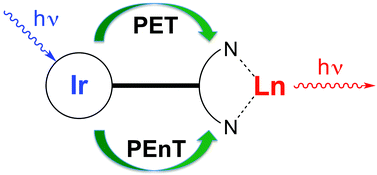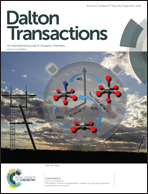Sensitisation of Eu(iii)- and Tb(iii)-based luminescence by Ir(iii) units in Ir/lanthanide dyads: evidence for parallel energy-transfer and electron-transfer based mechanisms†
Abstract
A series of blue-luminescent Ir(III) complexes with a pendant binding site for lanthanide(III) ions has been synthesized and used to prepare Ir(III)/Ln(III) dyads (Ln = Eu, Tb, Gd). Photophysical studies were used to establish mechanisms of Ir→Ln (Ln = Tb, Eu) energy-transfer. In the Ir/Gd dyads, where direct Ir→Gd energy-transfer is not possible, significant quenching of Ir-based luminescence nonetheless occurred; this can be ascribed to photoinduced electron-transfer from the photo-excited Ir unit (*Ir, 3MLCT/3LC excited state) to the pendant pyrazolyl-pyridine site which becomes a good electron-acceptor when coordinated to an electropositive Gd(III) centre. This electron transfer quenches the Ir-based luminescence, leading to formation of a charge-separated {Ir4+}˙—(pyrazolyl-pyridine)˙− state, which is short-lived possibly due to fast back electron-transfer (<20 ns). In the Ir/Tb and Ir/Eu dyads this electron-transfer pathway is again operative and leads to sensitisation of Eu-based and Tb-based emission using the energy liberated from the back electron-transfer process. In addition direct Dexter-type Ir→Ln (Ln = Tb, Eu) energy-transfer occurs on a similar timescale, meaning that there are two parallel mechanisms by which excitation energy can be transferred from *Ir to the Eu/Tb centre. Time-resolved luminescence measurements on the sensitised Eu-based emission showed both fast and slow rise-time components, associated with the PET-based and Dexter-based energy-transfer mechanisms respectively. In the Ir/Tb dyads, the Ir→Tb energy-transfer is only just thermodynamically favourable, leading to rapid Tb→Ir thermally-activated back energy-transfer and non-radiative deactivation to an extent that depends on the precise energy gap between the *Ir and Tb-based 5D4 states. Thus, the sensitised Tb(III)-based emission is weak and unusually short-lived due to back energy transfer, but nonetheless represents rare examples of Tb(III) sensitisation by a energy donor that could be excited using visible light as opposed to the usually required UV excitation.


 Please wait while we load your content...
Please wait while we load your content...